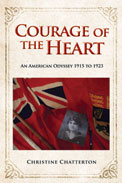
 |
In this age of seemingly endless celebrity worship, where little of lasting value needs to be created to elicit fawning adulation, it is all too easy to lose sight of the dignity, struggles, and achievements of what we too often refer to as ordinary people. The author of this book has performed a service by recounting the lives of two individuals who could easily fall into the category of Everyman and Everywoman. Yet their true story is anything but ordinary, and it reflects what human beings are capable of overcoming when devotion to one another is unending. Through interviews with the principals and people who knew them well, plus access to the personal letters they shared, a love story unfolds that overcomes distance, war, tragedy, disease, and more. Theirs is a compelling testament to the power of love.
Two small towns in Illinois just before America’s entry into World War I provide the locale. In one lives Maurice, a young man in his early twenties. In another lives Haidee, a dark-haired beauty still in high school. They meet at an annual picnic. Maurice is initially smitten. Haidee is more infatuated than she wants to admit. After that first meeting, they begin corresponding with one another via letters and, subsequently, visits. Their regard for one another grows, but there is a storm on the horizon. It becomes increasingly apparent that America is going to enter the war. Friends and family members are already starting to volunteer, including Maurice’s younger brother. Maurice feels incapable of staying home when so many are going off to fight for what they believe in. Soon he is overseas, and through letters that span time and oceans, Haidee becomes Maurice’s link to home as he becomes engulfed in the terrible realities of war.
Author Chatterton dramatizes both the battlefield and the home front as the war rages on. Haidee is forced to leave school and work to help provide for her family. Maurice is subjected to the horrors of trench warfare, poison gas, hunger, and more. Wounded and depressed, it is his correspondence with Haidee that buttresses his will to survive. When the war finally ends, and Maurice is sent home, the couple’s trials have not concluded. Tuberculosis threatens to end their relationship forever.
Throughout her narrative, Chatterton does a first-rate job of chronicling the times. The clothes that were worn, the food that was cooked, the transportation that was used, and the social mores of small-town existence all combine to paint a vivid picture of life in early twentieth century America. The author is no less adept at capturing the cold, rain, and mud of the trenches in France plus the fear and despair in the field hospitals and convalescent centers. On a more intimate scale, when dialogue is used it ably reflects the tone and tenor of the personal letters that are at the heart of her story. Conversations that have been recreated feel authentic and credible, as do interactions between friends, families, and even soldiers in the field.
Histories in textbooks can provide dates and places and facts. They give us information on an intellectual level. Histories dramatized, as in this work by Chatterton, are so much more emotionally compelling. It is interesting and worthwhile to know that the total number of military and civilian casualties in World War I was about forty million. It is infinitely more involving to discover how two people like Maurice and Haidee lived and loved during this incredible chapter of the American experience.